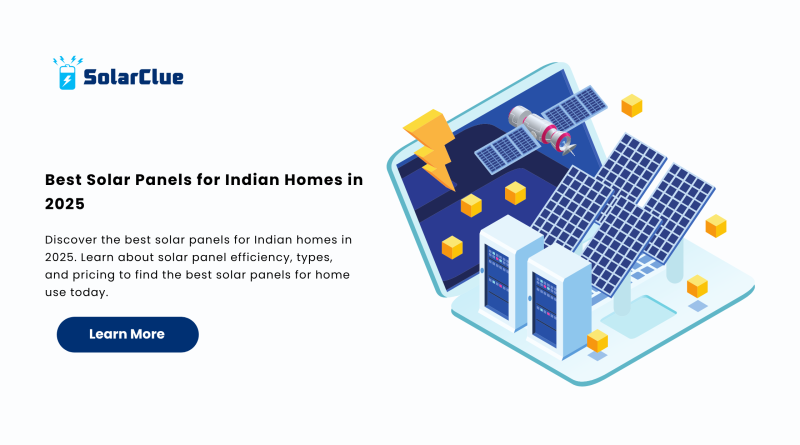Best Solar Panels for Indian Homes in 2025
India’s energy needs are surging, and the shift to renewable energy is no longer a luxury—it’s a necessity. For homeowners across the country, choosing the best solar panels for Indian homes is a critical decision in 2025. This guide helps you understand which solar panels perform best, how they work, what they cost, and why you need to act now.
Table of Contents
- 1 Why You Should Switch to Solar in 2025
- 2 Understanding Solar Panel Technology
- 3 Features to Consider While Choosing Solar Panels
- 4 Top Brands Offering the Best Solar Panels for Indian Homes in 2025
- 5 Installation: Making the Most of Solar
- 6 Government Subsidies for Solar Panel Installation
- 7 How Much Do Solar Panels Cost in India (2025)?
- 8 Net Metering and ROI
- 9 Environmental Impact of Solar Adoption
- 10 Common Myths About Solar Panels
- 11 Real-Life Success Story
- 12 Expert Tips Before Buying
- 13 FAQs
Why You Should Switch to Solar in 2025
With rising electricity prices and unpredictable power cuts, solar panels offer a reliable and cost-effective solution for Indian homes. Beyond saving on bills, solar installations reduce environmental impact and qualify for subsidies through various government schemes.
Installing the best solar panels for home guarantees long-term savings and energy independence. Over time, the initial investment pays off, thanks to low maintenance and decades of clean energy production.
Understanding Solar Panel Technology
To make an informed purchase, let’s explore the different types of solar panels available and their solar panels efficiency:
Monocrystalline Solar Panels
These are the most efficient solar panels, with a conversion efficiency of 18%–22%. They are made from pure silicon and perform better in high-temperature regions like Rajasthan or Telangana.
Polycrystalline Solar Panels
More affordable, these solar panels offer 16%–18% efficiency and are ideal for medium-sized homes. While slightly less efficient, they are reliable and durable.
Thin-Film Solar Panels
Lightweight and flexible, these are great for large installations or commercial use. Their solar panel efficiency ranges between 10%–13%, so they are less common in residential setups.
Features to Consider While Choosing Solar Panels

1. Solar Panels Efficiency
Higher efficiency means you need fewer panels to generate the same amount of electricity. Look for 18% or higher efficiency ratings when choosing the best solar panels.
2. Build Quality and Durability
Top brands offer solar panels that are resistant to extreme weather conditions and certified for performance over 25 years.
3. Warranty
Always choose panels with at least 25 years of performance warranty and 10–12 years of product warranty.
4. Compatibility with Inverters
Your solar panels for home must be compatible with existing or planned inverters for smooth operation.
Top Brands Offering the Best Solar Panels for Indian Homes in 2025
Waaree Energies
One of India’s leading manufacturers, Waaree offers monocrystalline and polycrystalline panels with high solar panels efficiency and strong local support.
Tata Power Solar
Backed by a trusted Indian brand, these solar panels provide reliability, performance, and after-sales service across India.
Adani Solar
These best solar panels for Indian homes come at affordable pricing with decent efficiency and long warranties.
Vikram Solar
Known for R&D and high-performance panels, Vikram offers a variety of solar solutions suitable for rooftops.
Loom Solar
A new entrant with innovative designs and compact kits, Loom Solar is growing quickly in the residential segment.
Installation: Making the Most of Solar
The placement and positioning of your solar panels matter more than you think. South-facing roofs receive maximum sunlight. Avoid shaded areas and clean your panels monthly to maintain optimal solar panel efficiency.
Installation Checklist:
- Conduct a site survey
- Check rooftop strength
- Ensure inverter compatibility
- Apply for net metering (to sell excess power)
Government Subsidies for Solar Panel Installation
The Indian government provides incentives under the Rooftop Solar Programme Phase II:
- Up to 40% subsidy for residential projects up to 3kW
- 20% subsidy for capacity between 3kW–10kW
- Additional subsidies in states like Gujarat, Maharashtra, and Kerala
Make sure your vendor is MNRE-approved to qualify.
How Much Do Solar Panels Cost in India (2025)?
| Capacity | System Cost (₹) | Subsidy (Approx.) | Net Cost (₹) |
|---|---|---|---|
| 1 kW | 45,000–60,000 | 18,000–24,000 | 27,000–42,000 |
| 3 kW | 1,35,000–1,80,000 | 54,000–72,000 | 81,000–1,08,000 |
| 5 kW | 2,25,000–3,00,000 | 45,000–60,000 | 1,80,000–2,40,000 |
Net Metering and ROI
With net metering, your unused solar power is exported to the grid, earning you credits. Most homeowners recover their initial investment in 4–6 years, thanks to reduced power bills and net metering benefits.
Environmental Impact of Solar Adoption
Every household that installs solar panels prevents 1.5–2 tons of CO₂ emissions per year. Widespread use of the best solar panels for Indian homes helps tackle climate change, conserve natural resources, and reduce dependence on coal-based energy.
Common Myths About Solar Panels
Myth 1: Solar panels don’t work in monsoon.
Truth: They work with diffuse sunlight and have battery backups.
Myth 2: Solar panels require daily maintenance.
Truth: A monthly cleaning schedule is usually enough.
Myth 3: Installation is complicated.
Truth: Most MNRE-approved installers complete projects in 2–5 days.
Real-Life Success Story
In Pune, a 5-member household installed a 3kW Tata Power system. Their average electricity bill dropped from ₹2,700 to ₹300. With a net metering setup, they expect full ROI within 4 years. The homeowner reported improved appliance usage and minimal maintenance issues.
Expert Tips Before Buying
- Always buy from a reputed brand.
- Read customer reviews.
- Verify warranty and AMC (Annual Maintenance Contract).
- Hire only MNRE-listed vendors.
- Check if your DISCOM supports net metering.
FAQs
1. What is the average lifespan of solar panels?
Most panels last 25–30 years with consistent performance.
2. Do solar panels work during cloudy days?
Yes, though output is lower, most panels still generate power.
3. What is the best panel type for Indian weather?
Monocrystalline panels perform best in varied conditions.
4. Can I power my entire home with solar?
Yes, with a properly sized setup and hybrid inverter.
5. What’s the ideal size of a solar system for a 3BHK home?
A 3–5kW system is typically sufficient.
If you’re ready to make the switch to cleaner energy and save on your bills, explore India’s top-rated solar panels at solarclue.com. And for expert advice, case studies, and detailed guides, head to blog.solarclue.com — your solar journey starts here!




